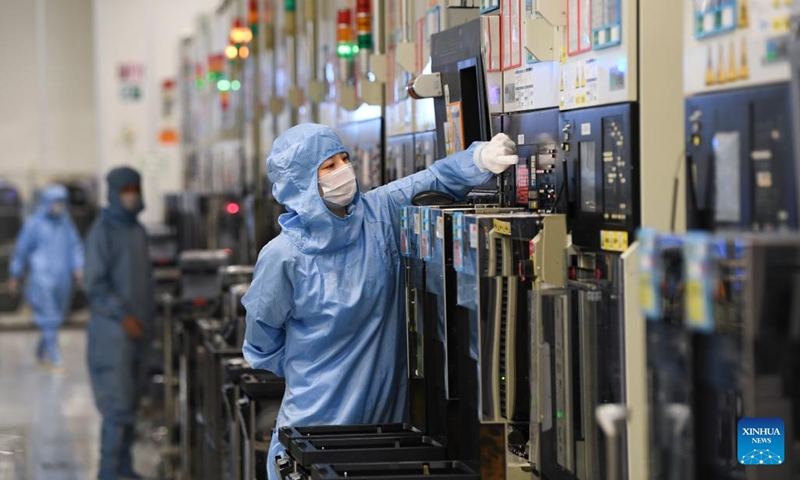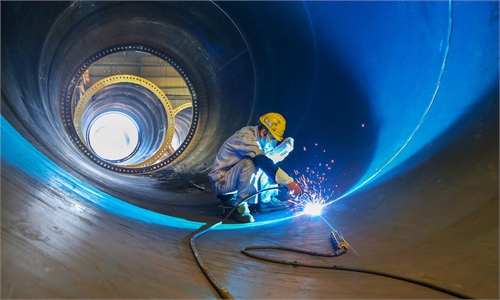China’s manufacturing sector continues to recover in August, enterprises’ confidence improves

Workers work at a semiconductor wafer workshop of a company in the Western Science City in southwest China's Chongqing Municipality, Aug. 24, 2023. (Xinhua/Wang Quanchao)
China's official manufacturing purchasing managers' index (PMI) continued to improve in August, marking the third consecutive year-on-year increase, although the index still remained in contraction territory.
With strong growth-reinforcing signals from the country's top policymakers and a package of stimulus measures gradually landing, it is expected that the index will enter expansion territory in September and maintain momentum until the fourth quarter, analysts told the Global Times.
The official PMI came in at 49.7 in August, up 0.4 points from the previous month, data from the National Bureau of Statistics (NBS) showed on Thursday.
A reading below 50 indicates a contraction, while one above 50 indicates expansion.
Among the 21 surveyed sectors, 12 reported month-on-month expansions in August, up from 10 in the previous month.
The production sub-index stood at 51.9, up 1.7 points, while the new orders index came in at 50.2, up 0.7 points from July, both hitting five-month highs.
Notably, the new orders index moved into the expansion range for the first time since April, indicating the warming-up of production demand.
Driven by improvements in manufacturing production and market demand, corporate purchasing activities accelerated, pushing the purchasing volume index to 50.5 in August, 1.0 points higher than in July.
The PMIs for large, medium-sized and small industrial enterprises all rose month-on-month.
With the recent concentrated launch of economic stimulus measures, enterprises' confidence in the market has been reinforced.
The index of expectations for production and business activities came in at 55.6 in August, up 0.5 points from July, remaining relatively high for the second consecutive month.
The index of expectations stayed in expansion territory across all sectors except for textiles.
Sectors such as agricultural and sideline food processing, vehicles and others had a stronger outlook, with their index readings exceeding 60, NBS statistician Zhao Qinghe said on Thursday.
Tian Yun, a Beijing-based veteran economist, told the Global Times on Thursday that it's quite likely the manufacturing PMI will move into expansion territory in September and maintain a stable momentum of expansion into the fourth quarter, as stimulus measures gradually take effect.
Chinese policymakers ranging from the State Council and the top economic planner to the Ministry of Commerce and the central bank have intensively launched stimulus measures over the past two months to boost consumption and rejuvenate growth momentum.
Despite the overall improvement in China's manufacturing sector, Zhao said that weak demand is still the main problem faced by enterprises, and the foundation for the recovery of the manufacturing industry needs to be further consolidated.
"There are still some constraints on the expansion of the domestic manufacturing industry," Wu Chaoming, a deputy head of the Chasing Research Institute, told the Global Times on Thursday.
China's property sector is still a major drag on the economic recovery, and it has even limited manufacturing growth, Wu said, adding that new measures to support the real estate market will take time to have an effect.
Additionally, slack overseas demand is a drag on exports and thus on industrial production.
China is scheduled to release trade data for August in early September. Foreign trade grew by 0.4 percent year-on-year in the first seven months of 2023 to 23.55 trillion yuan ($3.28 trillion), according to the General Administration of Customs. The low rate of increase was mainly caused by a relatively high comparison base last year, a slowdown in overseas demand and falling commodity prices.
"Also, the manufacturing industry still needs some time to digest the backlog of inventory," Wu added.
Wang Qing, chief macroeconomic analyst at Golden Credit Rating International, said in a note sent to the Global Times on Thursday that the recovery momentum of the economy is apparently getting stronger, as reflected by the new data.
"However, the index is still running at a low level, meaning more muscular tools to bolster the economy could be expected next, in particular in the property sector," Wang said.
Thursday's data also showed that the non-manufacturing PMI, which came in at 51 in August, has stood well above the 50 mark for eight consecutive months, indicating vitality in the services sector.
Summer holiday consumption has played an apparent driving role for the services sector, the NBS said. The index of business activity in such areas as railway and air transportation, catering, culture, sports and entertainment all remained above 55, pointing to a rapidly growing pace.


